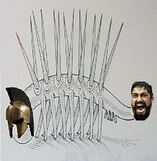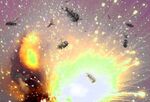Burgess Shale Hoax

The Burgess Shale Hoax was conceived and executed during the summer of 1909 by Charles Doolittle Walcott near the town of Field, British Columbia. Taking an extended vacation out of his home country and away from the hectic and competitive environment that comes with being the Secretary of the Smithsonian Institution, Walcott hatched an elaborate and brilliant plan to explain his absence. The plan worked, but too well, and would have drastic consequences for the pseudoscience of natural selection.
History[edit]
What began as a few letters[1] and simple journal entries [2] soon led to peer-reviewed scrutiny and a flood of 'landmark' papers. Walcott immediately employed his wife, Helen, and second-eldest son Sidney to sculpt pictures of animals on thin pieces of grey shale. Helen's manic obsession with one animal, dubbed Marrella, was plainly obvious, as more than 12,000 examples exist today.
Eventually the hype subsided, and the public and scientific communities basically ignored the fossil treasure trove known as the Burgess Shale until 1967, when the Geological Survey of Canada decided to celebrate Canada's 100th anniversary as a nation by 'reopening' Walcott's Quarry. Of course they quickly discovered there was nothing to be found, and so they embarked on a clever hoax of their own. But lacking the skill and style of the original 'discoverers', the team (led by none other than world trilobite authority, Harry Whittington) had to excavate a new quarry with a unique fauna of its own. That solved the problem of having to draw zillions of the meticulously detailed Marrella; in fact, the dominant organisms became simple worms (Ottoia), sponges (Choia) and fantastic and bizarre -- but rare -- dominant predators like Opabinia. So, the Geological Survey crew had a relatively easy time, scratching squiggles and starburst patterns that, to the untrained eye, were clearly significant fossils.
You'd think that was enough publicity, but another rising star in fossil attention seeking schemes would come along in 1975, begging the parks to let him sample fossils from the spoil heaps and talus slopes of previous excavations, ostensibly for the purpose of making collections for institutions too poor to fund such ambitions projects, and guess what? They let him. Des Collins, fastest beer drinker in the Western Hemisphere and senior curator of paleobiology at the Royal Ontario Museum spent the next 26 years hiring large crews of aspiring student artists to compose 'new' fossil assemblages -- seven new ones, in fact. New animal scratchings had to be developed as new artists and styles came and went. So large and devilish was this undertaking that new localities had to spring up along a twenty-five kilometre stretch of inaccessible mountain ranges, far from prying eyes that would have given up their great secret. Year after year, giant piles of money rolled in and yet, curiously, few publications emerged. Even more suspiciously, a professional artist by the name of Marianne Collins (no relation, seriously) was actually hired to draw pictures that would find their way into Stephen Gould's famous book[2]. Most of that money is rumoured to have been spent on beer, which accords well with the reputed habits of both geologists and students. The most notable student to actually produce a Burgess Shale-related thesis was Matt Devereux, who has gone on to produce other notable works, including this one.
Significance[edit]
Aside from duping the scientific community into thinking it had found the physical evidence comprising the smoking gun that would later define the Cambrian Explosion, and thanks to Gould's wildly popular account, public interest overflowed. The Nature of Things, the National Film Board (even toting the famous IMAX camera equipment), and magazines from across the world, including the principal funding agency of this farce, National Geographic, all put out articles and episodes explaining how important the site was.
The usual claim, if you ever saw one of these things, was that the fauna was preserved at a critical time in Earth's history. Animals, you see, had just developed into the basic body plans observed today, and were represented by unusual forms. Ooookay ... And guess what else. Yep. They claimed that the soft tissues, normally reclaimed by nature and thus selectively removed from the fossil record, were preserved in exquisite detail.
Of course, if you ever want to see these fossils for yourself, forget it. Endless delays plus funding complications at the Royal Ontario Museum will prevent that from ever happening. The Smithsonian (National Museum of Natural History) may put a few behind glass, but it's probably so dusty that you're likely to take their word for it unless you happen to read this first.
Footnotes[edit]
- ↑ "I had a few days collecting in the Stephen formation in the vicinity of Field in September, and found some very interesting things. Please find enclosed the pornography which I borrowed before my trip. The Missus has joined me, and I have found few opportunities to make use of it." --Letter to Professor W. A. Parks, University of Toronto, dated November 27, 1909.
- ↑ See Pg. 73 of Wonderful Life by Stephen J. Gould, 1989.


